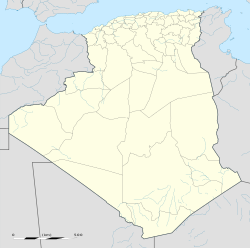City and Common in Skikda, Algeria
Collo (Arabic: القل, romanized: al-Qull), known as Chullu in antiquity, is a port town in the Skikda Province in northeastern Algeria, and forms part of the Collo Massif region. It is the capital and one of three municipalities of the Collo District.
Formerly a Phoenician trading post, then a Numidian and Roman port, Collo became under the Hammadids the port of Constantine. Today it is a small seaside town of about 35,000 inhabitants in 2008.
History
In Roman times, Collo was a city in the province of Numidia, called Chullu. At the joint Conference of Carthage (411) that brought together Catholic and Donatist bishops of Roman Africa, Chullu was represented by the Catholic bishop Victor and the Donatist Fidentius.[1][2][3]
In 1282, king Peter III of Aragon led an expedition to Collo, in proclaimed support of a rebellion against the ruler of Tunis. The rebellion had collapsed before Peter arrived, but he kept his army there for several weeks until, in the wake of the Sicilian Vespers, envoys from Sicily came to Collo to offer him its throne. The resulting war continued until 1301.
Geography
Collo has a total area of 9 square miles (23 km2). The city is distinguished by its containing of a mountain range, the most prominent of which are el Goufi 3,881 ft (1,183 m), Sidi Achour 1,771 ft (540 m), and the Tars Mountains. It is known for its various beaches and tourist attractions.
Climate
Collo's climate is classified as warm and temperate. The rain falls mostly in the winter, with relatively little rain in the summer. According to the Köppen Climate Classification system, this climate is classified as "Csa". The average annual temperature is 63.1 °F (17.3 °C), and precipitation is about 32.32 in (821 mm) per year.[4]
| Climate data for Collo, Skikda (1991-2021 normals)
|
| Month
|
Jan
|
Feb
|
Mar
|
Apr
|
May
|
Jun
|
Jul
|
Aug
|
Sep
|
Oct
|
Nov
|
Dec
|
Year
|
| Average high °F (°C)
|
56.6
(13.7)
|
56.9
(13.8)
|
61.8
(16.6)
|
66.1
(18.9)
|
72.2
(22.3)
|
80.4
(26.9)
|
87
(31)
|
87.7
(30.9)
|
80.8
(27.1)
|
75
(24)
|
64.6
(18.1)
|
58.7
(14.8)
|
70.7
(21.5)
|
| Daily mean °F (°C)
|
50
(10)
|
49.9
(9.9)
|
53.9
(12.2)
|
58.3
(14.6)
|
64.4
(18.0)
|
78.1
(25.6)
|
78.1
(25.6)
|
78.7
(25.9)
|
73.3
(22.9)
|
67.5
(19.7)
|
58
(14)
|
52.3
(11.3)
|
63.5
(17.5)
|
| Average low °F (°C)
|
43.9
(6.6)
|
43.3
(6.3)
|
46.6
(8.1)
|
50.8
(10.4)
|
56.8
(13.8)
|
69.6
(20.9)
|
69.6
(20.9)
|
70.8
(21.6)
|
66.9
(19.4)
|
61.2
(16.2)
|
52.2
(11.2)
|
46.4
(8.0)
|
56.5
(13.6)
|
| Average precipitation inches (mm)
|
4.4
(112)
|
3.9
(99)
|
3.2
(82)
|
2.9
(73)
|
2.0
(51)
|
0.6
(14)
|
0.1
(3)
|
0.5
(12)
|
2.0
(52)
|
3.2
(82)
|
4.8
(122)
|
4.7
(119)
|
32.3
(821)
|
| Average precipitation days
|
10
|
9
|
8
|
8
|
5
|
2
|
1
|
2
|
6
|
8
|
11
|
10
|
80
|
| Average relative humidity (%)
|
80
|
78
|
78
|
78
|
76
|
69
|
64
|
65
|
71
|
75
|
77
|
79
|
74
|
| Mean daily sunshine hours
|
6.2
|
6.8
|
8.0
|
9.2
|
10.5
|
11.9
|
12.3
|
11.3
|
9.5
|
8.2
|
6.8
|
6.2
|
8.9
|
| Source: climate-data.org[4]
|
Titular bishopric
In 1833, the Roman diocese was nominally revived as a titular see of the lowest (episcopal) rank.
So far, it had four incumbents:



